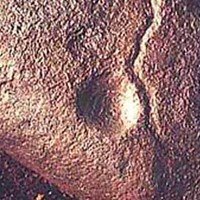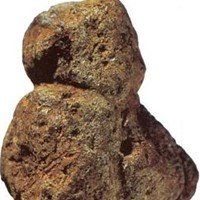SailingCyclops wrote: The broader question is when did art itself become manifest? There is much evidence that it began between 300,000 and 700,000 years ago.
When Was Art First Created?According to the latest paleo-archeological information, the oldest art was created by humans during the prehistoric Stone Age, between 300,000 and 700,000 years ago.
Let’s look at the art from your source.

It claims “The oldest known art of prehistory. A cupule at the Auditorium Cave at Bhimbetka, Madhya Pradesh, India. It dates from (290,000-700,000 BCE).”
It is disputable that this would be considered art, or even made from man.
Here is another image:

It claims “Venus of Berekhat Ram dating from 230,000 – 700,000 BCE.”
Frankly, it looks like a plain ole rock to me.
Also, just because a rock might look like something doesn’t mean it’s manmade (or even hominid made).
Now, if you want to look at a rock that appears manmade that is really old, take a look at Klerksdorp spheres.
If one considers the artistic nature of early stone technology, then that has been shown to have existed about 1.6 million years ago:
From Cave Paintings to the InternetAcheulean or Mode 2 Industries Circa 1,650,000 BCE – 100,000 BCE
A flint biface, discovered in Saint-Acheul, France.
OK, I’ll post later to address stone artifacts.
https://debatingchristianity.com/forum/viewtopic.php?p=322813#p322813
SailingCyclops wrote: Frankly, it looks like an old rock to my untrained eyes as well.
If it looks like a duck…
Furthermore, microscopic analysis by Alexander Marshack appears to confirm that humans were responsible for the figurine.
This would be a stretch. How can one confirm that “humans” were responsible for supposed intentional grooves?
I think it’s quite ironic that evolutionists cannot accept things such as DNA is a result of intelligent design, but a groove in a formless rock is evidence for an intelligent cause.
Specifically, it exhibits three or more groove-like incisions, made by a sharp-edged stone, which give it the appearance of a human body.
One can seriously dispute that it looks like a human body.
One incision is a deep groove that encircles the narrower end of the pebble (indicating the head), while two shallower, grooves cut into the sides (marking the arms).
I can’t even discern what is the “head” and “arms”. Perhaps it was done by an abstract artist? ![]()
https://debatingchristianity.com/forum/viewtopic.php?p=324336#p324336

